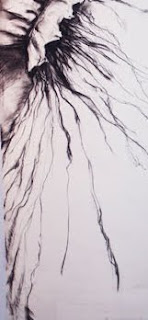It has been, as usual, a busy year. Somehow, the studio always "cooks." Yes, there are lulls and times that it feels like a true slog through quick sand, but the pull of the joy of touching materials keeps pulling me onward.
In March, my brother Jim helped me hang Eros and Thanatos in Richmond, VA. He will do the same at Seminole State College, in Florida, sometime in 2019...unless he is traveling the world. He caught my parent's wanderlust.

In May, Kim Matthews and I hung our show Platonic Dualities, in Robbinsdale, MN. It seemed like an unlikely location for a financially successful show...but it was. The gallery, Kim and I promoted the heck out of it and people came and spent money. It was a huge push to put this show together on relatively short notice. Afterwards, Kim and I promptly fell into studio quicksand!
There were 10 or 12 group shows as well, from Alaska to Brooklyn, NY. Small things, big things, and various things in between.
And now, we approach the new year in some form of transition, also as usual. Something about the arbitrary change of numbers on the calendar always makes me try to evaluate, muse and plan. It has only just begun.
The biggest decision concerned my ageing/my studio. The size of my studio is barely adequate. The 3 flights of stairs are periodically a lot harder than they used to be, especially in the summer when my arthritis hurts almost constantly. I briefly thought about developing a property, probably in the suburbs, where I could live and work in vast space. But, I have wonderful friends and neighbors who look out for me here, in this neighborhood. I also know what it takes to MOVE, to renovate and recreate a daily life. I just do not have the energy to take that risk again! So, I got in an ageing consultant, made a few minor changes around the house, and committed to stair lifts! I'm STAYING until the end, or a wheelchair, whichever comes first! And I will never stop working in the studio. Old artists never retire.










 First, I resized the opening.
First, I resized the opening.




























